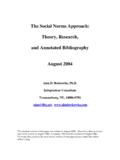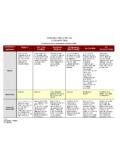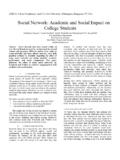Transcription of What social media sites do college students use most?
1 Journal of Undergraduate Ethnic Minority Psychology 2016 Spring; 2 21 Abstract college students rely on the Internet generally and social media sites specifically to connect with others. This study seeks to determine what social media sites college students use most. students (N=363) completed a survey which assessed personal use of social media . Surveys were distributed face-to-face and online. Overall, Instagram was the most used social networking site followed by Snapchat and Facebook. The least used social networking sites were Linkedin and Pinterest. Most (76%) use social networking sites 1-10 hours each day and a slightly larger proportion (80%) indicated they use the sites more on the weekend.
2 students are most likely to use social networking sites that enable them to post pictures and videos. They are least likely to use social networking sites that enable them to develop a professional network or post media content into organized categories. social media sites are increasingly tailored to meet the needs of specific target markets. Understanding this evolutionary pattern is the key that unlocks which social media platforms college students will continue to use most. Index Terms social media , use, college , student INTRODUCTION he Internet is evolving at a rapid pace. According to the number of Internet users has grown by more than 30 million from 1995 until 2014.
3 Users are relying on social media now more than ever. Since the creation of social media networks, the Internet has become the most popular tool for teens and young adults. social media usage is particularly high among young adults and college students because students embrace new media quickly (Lenhart, Purcell, Smith, & Zickuhr, 2010). Most students use social media to create a personal profile, post what they are doing throughout their day, upload pictures, Manuscript received May 2015, resubmitted and accepted October 2015. Student co-authors are (or were at the time the research was conducted) undergraduate students at Alabama State University.
4 Richard Emanuel, Ph. D., is a Professor of Communications at Alabama State University (915 South Jackson Street, Montgomery, AL 36101; and send messages to their friends and family. social media are also used to develop a professional network to establish and strengthen relationships in the business world. Literature Review social networking sites have become the latest online communication tool that allows users to create a network with a public or private profile and interact with people in that network (Boyd & Ellison, 2008). social media can include blogs, wikis, media (audio, photo, video, text), sharing tools, networking platforms, and virtual worlds (Boyd & Ellison, 2008).)
5 social media sites fulfill many wants and needs via virtual communication. It is a What social media sites do college students use most? Jasmine Knight-McCord, Dylan Cleary, Nastassjia Grant, Antoinette Herron, Success Jumbo, Tiffany Lacey, Torri Livingston, Sky Robinson, Renardo Smith, and Dr. Richard Emanuel Alabama State University T Journal of Undergraduate Ethnic Minority Psychology - 2016 Spring; 2 22 convenient method of communication which provides the ability to stay connected with friends and family at the discretion of the users own rate and time (Urista, Dong, & Day, 2009). social media are highly efficient because they are one of many methods of communication that allow users to quickly and widely disseminate information.
6 According to Duggan and Brenner (2012), 83% of 18-29 year olds disseminate information via social networking sites . social media are increasing student engagement outside of the classroom and they are creating new and innovative ways to learn (see Ivala & Gachago, 2012; Bynum, 2011). Student engagement represents the time and effort students invest in their education. DeBell & Chapman (2006) pointed out that adolescent and young adults are the heaviest users of computers and the Internet. The average college student spends eight hours a day online (Kuh, 2001). However, college students have concerns about their Internet usage and balancing social life, extracurricular activities, and even part time jobs.
7 In particular, 70% reported that they stay online longer than they intend. This suggests that the ubiquity of and ease of access to the Internet are not without a potential downside (Christakis, Moreno, Jelenchick, Myaing, & Zhou, 2011, ). students view social media as a way to release pressure from school assignments (Wang, Chen & Liang, 2011). However, a balance between social media use and academic effort is imperative to improve student grades (Brydolf, 2007; Capano, Deris, & Desjardin, 2014; Junco, Helbergert, & Loken, 2011). social networking sites Facebook. The most popular social networking sites to date are Facebook (Rainie, Smith, & Duggan, 2013), followed by Twitter (Brenner & Smith, 2013) and LinkedIn (Duggan & Brenner, 2012).
8 Facebook allows users to set up a profile and post updates, links, photos, conversations, and the like. Sponcil & Gitimu (2007) reported that recognized Facebook as their preferred social media site (p. 7). Wang, Chen, and Liang (2011) reported that students spend roughly 100 minutes per day on Facebook. In 2007, 92% of college students reported that they had a Facebook account. By 2008, 99% of students had an account on Facebook (p. 5). Williams and Merten (2008) found that university students are often obsessed with their Facebook and Twitter profile. A study by Pempek, Yermolayeva, and Calvert (2009) showed that students spend an average of 28 minutes a day on Facebook (p.)
9 231). Student researchers from the Whitmore School of Economics and Business found that younger students tend to use Facebook more frequently than older students to keep in touch with friends from high school or from their hometown (Pempek, Yermolayeva, & Calvert, 2009). Many individuals use social network sites to feel popular, trying to add as many friends as possible so they appear to be more admired. Young adults reported an average of 358 Facebook friends (Pempek, Yermolayeva, & Calvert, 2009, p. 236). Quan-Haase and Young (2010) found that 82% of college students reported logging into Facebook several times a day. Twitter. Twitter allows users to send out short messages or tweets about what they are doing or links to resources of interest.
10 People can choose to follow selected users tweets and they can retweet or repost someone s tweet for others to see. It is an online version of text-messaging with the capability of sending the same message to several thousand people all at once (Ezumah, 2013). Linkedin. Linkedin is targeted at professionals interested in professional networking. Each user sets up a profile similar to a resume and then can link to other people that they know. Having been created in 2003, LinkedIn is one of the oldest social networks. However, this particular site is relatively new to younger generations. Facebook, Twitter and Linkedin are being joined by a complete new line of competitors in the social media business.








